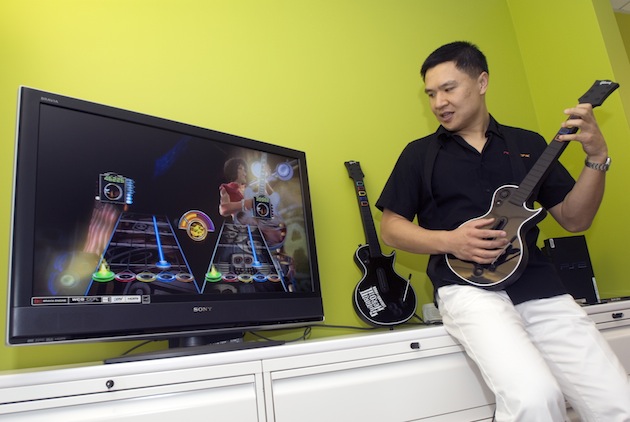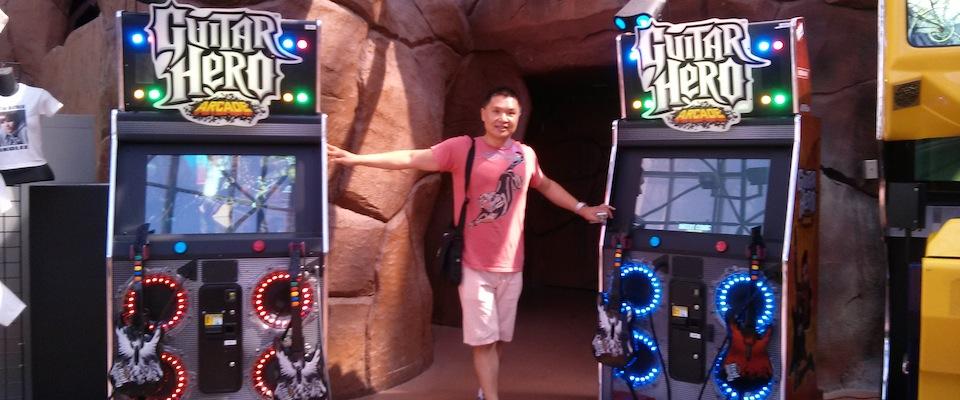So what do you do when you’re a co-producer of one of the best-selling video games of all time—more than that, a video game that has become a pop culture icon, so ubiquitous that it earned the ultimate gaming accolade?
You do whatever you want, of course. And for Charles Huang, that means more of the same: Pushing at the bleeding edge of tech, that margin that anticipates the future of consumer tastes rather than accommodates existing trends. With his brother Kai, Huang is the co-founder of RedOctane, the company that created Guitar Hero, the game that moved air guitar into the realm of the real and palpable. The game posted a billion dollars in sales annually between 2007 and 2009 and (pop culture accolade referenced here) was the subject of a South Park episode in 2007.
“Actually, we were a little concerned when we heard that it was going to be featured on South Park,” Huang laughs. “But it was a very funny episode. And the producers told us it was the top-rated show for that season.”
Huang was born in Taiwan. His family immigrated to the United States when he was in first grade, settling in New York and opening a grocery store. In the 1980s, when he was in junior high, the family moved to Malibu, where his father started an auto parts import and export business. As he has noted in interviews, one of his dad’s pals was the head of Okie Semi-Conductor, which manufactured chips for the early Atari video games, most notably Pong. Predictably, Charles and Kai got hooked on Atari’s bouncing digital balls, and a larger interest in video games and the computer industry blossomed.
Both brothers graduated from UC Berkeley—Charles majoring in economics and Asian studies; Kai majoring in computer science. Then Charles went to work for his father’s business, where he learned about manufacturing by touring factories in Taiwan and China. But his passion for high tech—and especially, gaming—never waned.

And when the dot-com boom manifested, the brothers were ready to jump in; they launched RedOctane in 1999.
RedOctane originally produced dance pads. But the Huangs spent a lot of time in Asia investigating emerging recreational technologies, and noticed that music games were especially popular—including a proto-guitar game called Guitar Freak. The brothers refined the concept, and teamed with Harmonix, a Massachusetts-based music game development studio. RedOctane made the hardware, Harmonix developed the software, and voila: Guitar Hero, the game that has transformed millions of ham-handed adolescent Hendrix wanna-bes into rock virtuosos.
RedOctane and Guitar Hero were acquired by Activism for nine figures in 2006. Huang went along for the ride, helping design and market subsequent iterations of the game. He left the company in 2010.
“I had helped produce 10 versions of Guitar Hero between 2006 and 2010, five of them in a two-year period,” he says. “We also produced two versions of a related game, VJ Hero. So I was pretty burnt out.”
Obviously, Huang wasn’t going to miss any meals; Guitar Hero had set him up nicely. He could’ve spent the rest of his life cultivating heirloom dahlias or collecting Grand Cru clarets. But at heart, he remained a gamer and a tech freak. He needed to be in the middle of things. So since bailing from Activision, he has embarked on a variety of ventures, including: Blue Goji, a manufacturer of interactive fitness gear co-established with Kai and Coleman Fung (founder of the Coleman Fung Institute for Engineering Leadership at UC Berkeley); Green Throttle, which produced games and hardware for mobile devices and consoles (Google acquired the company in 2014); and Leeo, co-founded with Haas School of Business grad Eddy Chan, which produces “smart” nightlights that can alert absentee homeowners via smartphones about hazards including fire, intruders, and carbon monoxide concentrations.
And then there’s Indigo 7, his latest venture. The seeds for this start-up were planted during a visit to a Cal lab, says Huang.
“I saw some work involving sensors employed directly in fabrics, and I realized this is where we’re heading. Someday, we won’t have the sensor-enabled devices that we now use–smartphones, smart watches, and so forth. The sensors will be in our clothes. So we’re experimenting with wearable tech. Ultimately, you’ll be able to activate any number of sensors by simply swiping a spot on your clothes. Your shirt will be a touch screen.”
Huang also is involved with Valve, a manufacturer of virtual reality headsets and controllers. Last week, the company began shipping its Vive unit, anticipated as a breakthrough device by some technoscenti, to a select group of evaluators and game developers.

“For a long time, I was very skeptical about VR,” Huang says. “It’s been one of those technologies that was always going to be the Next Big Thing, and it’s been that way for years. But there were always those problems with vertigo, even nausea, caused by the lag factor in the headsets—when you moved, the images weren’t in sync. The designers could never get the images to precisely line up with head and eye position. But Valve has been working with HDC Mobile, and they’ve really made dramatic progress with Vive.”
Does Huang hope to hit it big with another Guitar Hero-type breakthrough?
“Guitar Hero took us to the summit of the video game industry, and sure, it was fun,” he says. “But these days, I’m a lot more interested in working on a smaller scale, in trying to think of things no one has thought of, and build things that no one has built. I’m finding that it’s a lot more fun to experiment with things in the early stages rather than marketing products based on mature technologies.”
Nor has he forgotten Cal, which he credits with much of his success. He lectures at the university’s Center for Entrepreneurship and Technology, and he has endowed a fund that will support up to 50 students in an advanced course of Chinese studies at both Berkeley and Beijing.
“I think the relationship between the U.S. and China is going to be the most important policy issue the world will face over the next 20 to 50 years,” says Huang, “and I want to do everything possible to foster connection and understanding. A group of Cal students in engineering, the arts and journalism, fluent in Chinese and conversant with Chinese culture, can help build those bridges.”





















